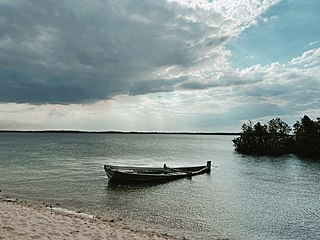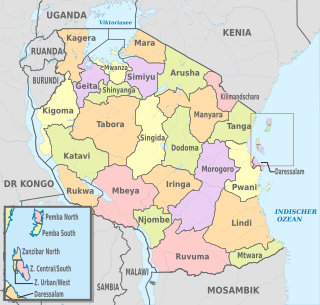Elsewhere
- Kilwa, Democratic Republic of the Congo, a town in the Democratic Republic of the Congo, on the south-west shore of Lake Mweru
- Kilwa Island, 6 km from Kilwa, Katanga, but in Zambian territory
Kilwa may refer to:

Mafia Island is an island off the coast of Pwani Region, Tanzania. The island is the third largest in Tanzanian ocean territory, but is not administratively included within the semi-autonomous region of Zanzibar, which has been politically separate since 1890. Mafia Island forms the major part of Mafia District, one of the six administrative districts in the Pwani coastal region. The local archipelago and the main island are sometimes called Chole shamba in Swahili, hinterlands of the former maintown of Chole on Mafia Bay.

Kilwa Kisiwani is an island, national historic site, and hamlet community located in the township of Kilwa Masoko, the district seat of Kilwa District in the Tanzanian region of Lindi Region in southern Tanzania. Kilwa Kisiwani is the largest of the nine hamlets in the town Kilwa Masoko and is also the least populated hamlet in the township with less than 1,000 residents. At its peak Kilwa hosted over 10,000 inhabitants in the Middle Ages. Since 1981 the entire island of Kilwa Kisiwani has been designated by UNESCO as a World Heritage Site along with the nearby ruins of Songo Mnara. Despite its significant historic reputation, Kilwa Kisiwani is still home to a small and resilient community of native residents that have inhabited the island for centuries. Kilwa Kisiwani is one the seven World Heritage Site located in Tanzania.
The Swahili people are a Bantu ethnic group inhabiting East Africa. Members of this ethnicity primarily reside on the Swahili coast, in an area encompassing the Zanzibar archipelago, littoral Kenya, the Tanzania seaboard, northern Mozambique, the Comoros Islands, and Northwest Madagascar. More recently, Swahili identity is centered around any person of African descent who speaks Swahili as their first language, is Muslim and lives in a town on the main urban centers of most of modern day Tanzania and coastal Kenya, northern Mozambique and the Comoros, through a process of swahilization.
Kilwa District is one of the five districts of the Lindi Region of Tanzania. As of the 2012 census, the population was Kilwa district was 190,744, making it the 2nd most populous district in Lindi region. The district seat (capital) is the town of Kilwa Masoko. The district is named after the medieval Swahili city state of Kilwa Kisiwani.

Lindi Region is one of Tanzania's 31 administrative regions. The regional capital is the municipality of Lindi. The region is home to two UNESCO World Heritage Sites, namely; Kilwa Kisiwani and Selous Game Reserve. According to the 2012 national census, the region had a population of 864,652, which was lower than the pre-census projection of 960,236. For 2002–2012, the region's 0.9 percent average annual population growth rate was the 29th highest in the country. It was also the least densely populated region with 13 people per square kilometer.
Kilwa Masoko is the seat of government for the Kilwa District and a port town in Lindi Region in southeastern Tanzania. Kilwa Masoko is the second largest town in Kilwa district with the population of 13,601 as of 2012.
Masoko is a Swahili word denoting "markets". It is the plural of "soko" which is derived from Arabic "سوق" (souq) meaning market.
The following is a list of the political history of East Africa.
Those interested in the subject can monitor changes to the pages by clicking on Related changes in the sidebar. Articles related to Tanzania include:

The Great Mosque of Kilwa is a congregational mosque on the island of Kilwa Kisiwani, in Tanzania. It was likely founded in the tenth century, but the two major stages of construction date to the eleventh or twelfth and thirteenth century, respectively. It is one of the earliest surviving mosques on the east African coast and is one of the first mosques built without a courtyard.

The Kilwa Sultanate was a sultanate, centered at Kilwa, whose authority, at its height, stretched over the entire length of the Swahili Coast. According to the legend, it was founded in the 10th century by Ali ibn al-Hassan Shirazi, a Persian prince of Shiraz. His family ruled the Sultanate until the year 1277. They were replaced by the Arab family of Abu Moaheb until 1505, when they were overthrown by a Portuguese invasion. By 1513, the sultanate was already fragmented into smaller states, many of which became protectorates of the Sultanate of Oman.

The following outline is provided as an overview of and topical guide to Tanzania:

The administrative divisions of Tanzania are controlled by Part I, Article 2.2 of the Constitution of Tanzania. Tanzania is divided into thirty-one regions. Each region is subdivided into districts. The districts are sub-divided into divisions and further into local wards. Wards are further subdivided for management purposes: for urban wards into streets and for rural wards into villages. The villages may be further subdivided into hamlets.

The Swahili coast is a coastal area of the Indian Ocean in Southeast Africa inhabited by the Swahili people. It includes Sofala (Mozambique), Mombasa, Gede, Pate Island, Lamu, Malindi, and Kilwa. In addition, several coastal islands are included in the Swahili coast such as Zanzibar and Comoros.
The Shirazi people, also known as Mbwera, are an ethnic group inhabiting the Swahili coast and the nearby Indian ocean islands. They are particularly concentrated on the islands of Zanzibar, Pemba and Comoros.

Kilwa Masoko Airport is an airport serving the town of Kilwa Masoko in the Lindi Region of Tanzania.
Lindi can mean:

On the Swahili Coast in southern Tanzania lie the ruins of a stone town known as Songo Mnara. The stone town was occupied from the 14th to 16th centuries. Songo Mnara has been recognized as a UNESCO World Heritage Site, along with nearby stone town Kilwa Kisiwani. In total, archaeologists have found six mosques, four cemeteries, and two dozen house blocks along with three enclosed open spaces on the island. Songo Mnara was constructed from rough-coral and mortar. This stonetown was built as one of many trade towns on the Indian Ocean.
The Goma, who also refer to themselves as Al ghamawiyyun in Arabic, are a tribe in the Kigoma Region in western Tanzania. They are a contingent of the Bantu tribe who are more commonly found in Tanzania and present-day Democratic Republic of Congo who migrated from the western shore of the Lake Tanganyika in Democratic Republic of Congo with origins from Sudan. They are the first group of the Bantu tribe to ever cross the Lake Tanganyika and also the first group to reside in the Urban District of Kigoma as its inhabitants. Following the Wagoma were Niakaramba (Kwalumona) from Cape Karamba and then Wabwari from Ubwari peninsula. The Kwalumona merged within Wabwari, identified themselves as Bwaris and settled north of Wagoma in Kigoma before resettling in Ujiji and its environs, where they formed a tribal Confederacy in Ujiji known as Wamanyema. The Wagoma crossed the lake early due to their invention of dug-out canoes mitumbwi ya mti mmoja curved from Mivule trees of Ugoma mountains from western shore of the Lake.
Dr Stephanie Wynne-Jones is an Africanist archaeologist, whose research focuses on East African material culture, society and urbanism. She is Senior Lecturer and Deputy Head of the Department of Archaeology at the University of York. She previously worked as Assistant Director of the British Institute in Eastern Africa (2005-2008) and remains a Trustee and Member of the BIEA Governing Council. In 2016, Wynne-Jones was elected to Fellowship of the Society of Antiquaries of London. Wynne-Jones is one of the Core Group at the Danish National Research Foundation Centre of Excellence in Urban Network Evolutions (Urbnet), Aarhus University. Between 2015 and 2017 she was a Pro Futura Scientia Fellow at the Swedish Collegium for Advanced Study, Uppsala.